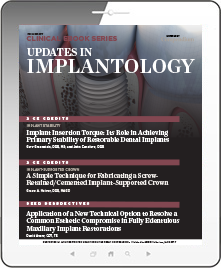Updates in Implantology
Wednesday, December 13, 2017
Commercial Supporter:

Volume 38 eBook 17
This special Compendium eBook explores factors for implant success. According to the authors of our first CE article, there are many factors that affect primary implant stability. The authors focus on the impact of insertion torque on acheiving predictable osseointegration. Our second CE article describes research that has demonstrated that screw-retained restorations have had more minimal complications than cement-retained. Our Peer Perspective article explores the option of incorporating angled access channels to achieve implantology success.
FEATURED CONTENT
CE 1: Implant Insertion Torque: Its Role in Acheiving Primary Stability of Restorative Dental Implants
Gary Greenstein, DDS, MS; and John Cavallaro, DDS
This article discusses the many issues affecting primary implant stability. The authors focus on the impact of insertion torque on achieving predictivity osseointegration. Because questions persist related to this effect, this extentive literature review covers research that clarifies what torque force should be used in various clinical scenarios.
Credits: 2 Self-Study CEU
Cost: $0
Provider: AEGIS Publications, LLC
CE 2: A Simple Technique for Fabricating a Screw-Retained/Cemented Implant-Supported Crown
Gregg A. Helvey, DDS, MAGD
This article describes research that has demonstrated that screw-retained restorations have had more minimal complications than cement retained. The author details a simple, low-cost technique of converting a cement-retained implant crown to a scew-retained implant crown, which allows for the fabrication of an esthetically pleasing, low-occlusal–imact restoration. In addition, the screw-retained implant crown alleviates the concern of residual cement leading to peri-implantitis.
Credits: 2 Self-Study CEU
Cost: $0
Provider: AEGIS Publications, LLC
PEER PERSPECTIVE: Application of a New Technical Option to Resolve a Common Esthetic Compromise in Fully Edentulous Maxillary Implant Restorations
David Avery, CDT, TE
This author explores the option of incorporating angled access channels. Utilizing a hexalobular driver/screw head combination to provide a distinct principle of engagement, this technology provides two major restorative benefits: The elimination of "space eating" angled abutments, along with the favorable repositioning of screw access holes to achieve esthetic positions.








